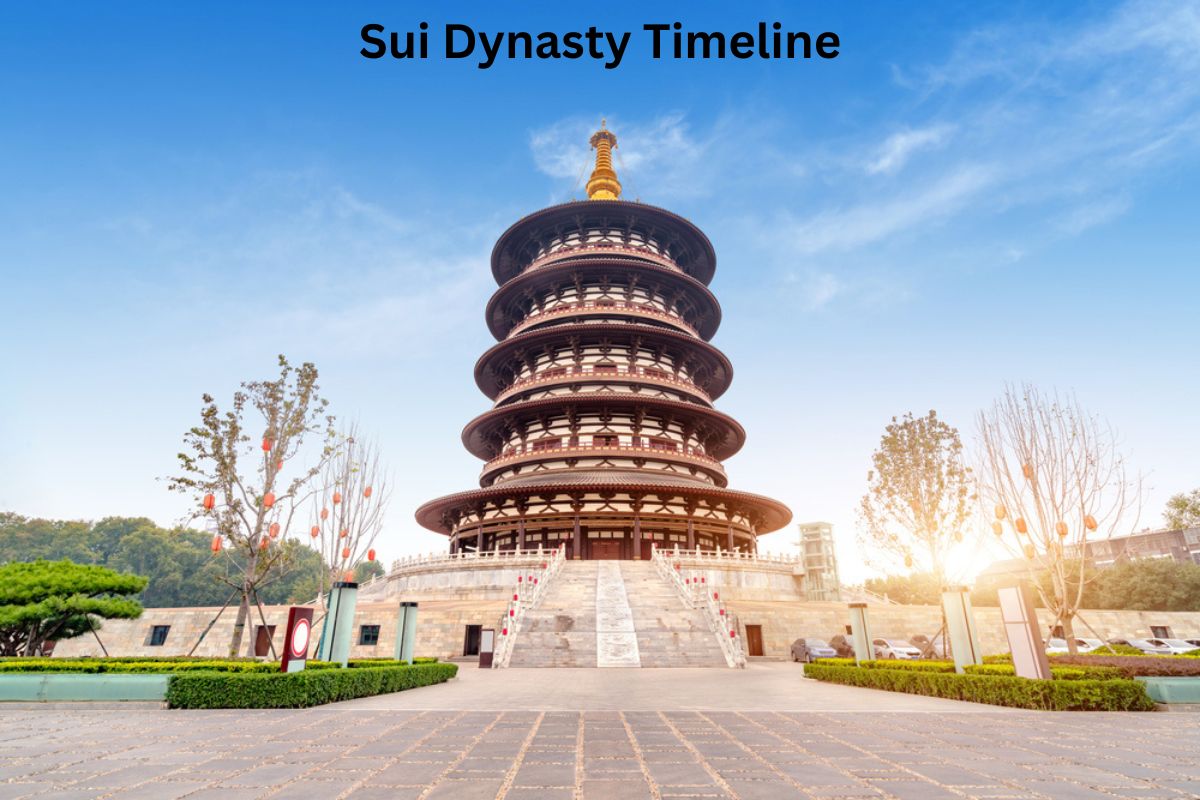The Sui Dynasty (581-618 AD) was a short-lived but pivotal dynasty in Chinese history, bridging the Northern and Southern Dynasties period with the prosperous Tang Dynasty.
Established by Emperor Wen, or Yang Jian, the Sui era is noted for unifying China after centuries of fragmentation. Despite its brevity, the dynasty embarked on monumental projects like the Grand Canal and sought territorial expansion.
However, heavy taxation, ambitious military campaigns, and internal strife eventually led to its downfall, making way for the Tang Dynasty under Li Yuan.
| Year | Event |
|---|---|
| 581 AD | Foundation of the Sui Dynasty by Yang Jian; he becomes Emperor Wen of Sui. |
| 589 AD | Reunification of China after the Sui Dynasty defeats the Chen Dynasty. |
| 605 AD | Start of the Grand Canal construction. |
| 607-609 AD | Buddhist Pilgrimage of Xuanzang to India. |
| 611-614 AD | Emperor Yang’s failed campaigns against the Goguryeo kingdom in Korea. |
| 617 AD | Onset of rebellions against the Sui Dynasty due to discontent with Emperor Yang’s rule. |
| 618 AD | End of the Sui Dynasty with the assassination of Emperor Yang; beginning of the Tang Dynasty by Li Yuan. |
Timeline of the Sui Dynasty
581 AD – Foundation of the Sui Dynasty by Yang Jian
Yang Jian, also known as Emperor Wen of Sui, rose to power by consolidating control over the Northern Zhou kingdom.
Also Read: Sui Dynasty Accomplishments
He successfully eliminated rivals and, with a combination of political maneuvering and military might, declared himself emperor, thus establishing the Sui Dynasty.
His rule marked the end of the period of disunion and warfare that characterized the Northern and Southern Dynasties period.
589 AD – Reunification of China after defeating the Chen Dynasty
The most significant achievement of Emperor Wen of Sui was the reunification of China. For nearly four centuries, China had been fragmented into various dynastic states, particularly during the era of the Northern and Southern Dynasties.
Also Read: Tang Dynasty Facts
In 589 AD, the Sui Dynasty launched a successful campaign against the southern Chen Dynasty, the last of the Southern Dynasties. After their defeat, China was once again united under a single imperial banner, marking a critical turning point in Chinese history.
605 AD – Start of the Grand Canal construction
The Grand Canal, conceived and initiated under Emperor Yang of Sui (Emperor Wen’s successor), is one of ancient China’s most magnificent engineering feats.
This extensive waterway system connected the Yellow River in the north to the Yangtze River in the south, thereby establishing a vital transportation and communication link between the agriculturally rich south and the political power centers in the north.
Also Read: Timeline of Chinese Dynasties in Order
The canal greatly facilitated trade, transportation, and administrative efficiency. Its construction, however, was a massive endeavor, requiring the labor of millions and resulting in significant hardship and loss of life.
Despite its challenges, the Grand Canal remains a testament to the Sui Dynasty’s ambition and vision, continuing to serve as a crucial waterway even today.
607-609 AD – Buddhist Pilgrimage of Xuanzang to India
Xuanzang was a renowned Chinese Buddhist monk and scholar. Discontented with the fragmented and sometimes inaccurate translations of Buddhist scriptures available in China, he decided to travel to India, the birthplace of Buddhism, to gather scriptures and gain a deeper understanding.
His journey was perilous, crossing vast deserts and mountain ranges. Upon reaching India, Xuanzang studied at the ancient Nalanda University and collected numerous scriptures.
After returning to China after more than a decade, he began the colossal task of translating these scriptures, significantly influencing Chinese Buddhism.
His travels were later fictionalized in the classic Chinese literature, “Journey to the West,” where he is accompanied by the Monkey King, Sun Wukong, and other characters.
611-614 AD – Emperor Yang’s failed campaigns against the Goguryeo kingdom in Korea
Emperor Yang, driven by ambitions of expansion, targeted the powerful Korean kingdom of Goguryeo. Despite his vast resources, Emperor Yang launched three major campaigns against Goguryeo, all of which ended in failure.
These campaigns drained the state’s coffers and required massive conscription, leading to widespread discontent among the populace.
The logistical challenges of supplying a distant army, combined with the formidable defenses of Goguryeo, including the capital’s strong fortifications and the use of guerrilla tactics by Goguryeo’s forces, thwarted the Sui Dynasty’s military ambitions.
617 AD – Onset of rebellions against the Sui Dynasty
The combination of Emperor Yang’s extravagant projects (like the Grand Canal), failed military campaigns, and heavy taxation led to widespread suffering and resentment among the populace.
Rebellions began breaking out across the empire, notably the Lushan Rebellion and various other uprisings by local warlords and disaffected members of the military.
The vastness of the empire and the numerous simultaneous rebellions stretched the Sui military thin, weakening the dynasty’s grip on power.
618 AD – End of the Sui Dynasty; start of the Tang Dynasty by Li Yuan
Amidst the backdrop of widespread rebellion, Emperor Yang was assassinated in a coup led by one of his generals in 618 AD. The chaos following his death provided an opportunity for Li Yuan, a prominent general and noble, to seize power.
Establishing himself in Chang’an (modern-day Xi’an), he proclaimed the start of the Tang Dynasty, taking the title Emperor Gaozu of Tang. Under Li Yuan and his successors, the Tang Dynasty would go on to become one of China’s most illustrious and prosperous eras.
